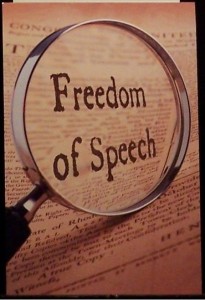 First Amendment cases in the context of employment and wrongful termination cases are highly technical. In order to make a claim against a government employer for violation of the First Amendment, an employee must show (1) that he engaged in a protected speech; (2) that the employer took “adverse employment action”; and (3) that speech was a “substantial or motivating” factor for the adverse employment action. Coszalter v City of Salem (2003). A public employee’s speech is protected under the First Amendment if the employee spoke “as a citizen upon matters of public concern.” Connick v Meyers (1983); Garcetti v Ceballos (2006). Whether an employee’s speech addresses a matter of public concern must be determined by the content, form, and context of a given statement, as revealed by the whole record. (Connick) If employee expression related to an issue of political, social or other concern to the community, it may fairly be said to be of public concern. Brewster v Bd. of Educ. of Lynwood Unified Sch. Dist. (1998).
First Amendment cases in the context of employment and wrongful termination cases are highly technical. In order to make a claim against a government employer for violation of the First Amendment, an employee must show (1) that he engaged in a protected speech; (2) that the employer took “adverse employment action”; and (3) that speech was a “substantial or motivating” factor for the adverse employment action. Coszalter v City of Salem (2003). A public employee’s speech is protected under the First Amendment if the employee spoke “as a citizen upon matters of public concern.” Connick v Meyers (1983); Garcetti v Ceballos (2006). Whether an employee’s speech addresses a matter of public concern must be determined by the content, form, and context of a given statement, as revealed by the whole record. (Connick) If employee expression related to an issue of political, social or other concern to the community, it may fairly be said to be of public concern. Brewster v Bd. of Educ. of Lynwood Unified Sch. Dist. (1998).
However, an employee’s motivation is relevant to the public-concern inquiry in a first amendment case. Desrochers v City of San Bernardino (2009). The question is why the employee spoke and whether the speech sought to bring to light actual or potential wrongdoing or breach of public trust, or whether it was just a dissatisfaction of one employee with his own employment situation. A speech that deals with individual personnel disputes and grievances and that would be of no relevance to the public’s evaluation of the performance of governmental agencies is generally not of public concern. (Desrochers) Thus, in Lambert v Richard (1995), the 9th Circuit held that a librarian’s statement to the city council at a televised city council meeting “that the library was ‘barely’ functioning and that employees who dealt regularly with the public were performing ‘devoid of zest, with leaden hearts and wooden hands'” constituted protected speech under Connick. The Lambert court emphasized that the employee in that case spoke as a union representative, not as an individual, and that she described departmental problems, not private grievances. In addition, the fact that the plaintiff in that case spoke at a televised city council meeting underlined the public nature of the controversy, and therefore the speech was held to be protected within the meaning of First Amendment claims.
Unlike in Lambert, the 9th Circuit found that the employee’s speech in Turner v City & County of San Francisco (2015) was not a protected speech. The court noted that Turner voiced his grievances internally – at union meetings, to his supervisor, and to the human resources – and they were specifically related to the conditions of his employment. Turner could have pursued a complaint with the San Francisco Civil Service Commission, gone to the Board of Supervisor for the city, gone to the press, or otherwise attempted to air his concern about improper compensation of city employee in a public forum, but he did not do so. In addition, the court noted, Turner’s complaints arose out of the ongoing personnel dispute about his alleged misclassification as a temporary exempt employee rather than a permanent employee. Further, unlike the plaintiff in Lambert, Turner was not seeking broad-based union action or relief on behalf of other similarly situation employees, but he was only advocating on his own behalf. Such individual personnel disputes and grievances are generally not of public concern. (Desrochers)
Relying on the above factors and evaluating whether the speech in question was a “protected speech” is a critical issue in evaluating and deciding whether to bring a case for First Amendment violation against a public entity – employer.